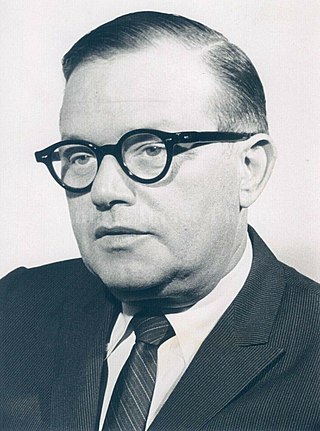
Jule Styne was an English-American songwriter and composer widely known for a series of Broadway musicals, including several famous frequently-revived shows that also became successful films: Gypsy,Gentlemen Prefer Blondes, and Funny Girl.
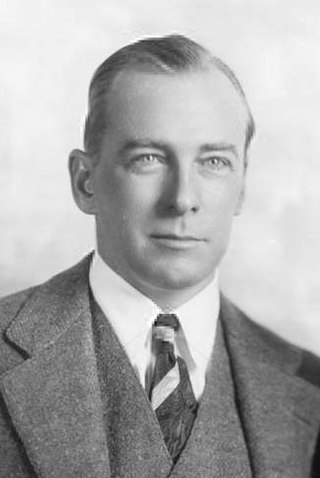
George Francis Abbott was an American theatre producer, director, playwright, screenwriter, film director and producer whose career spanned eight decades. He received numerous honors including six Tony Awards, the Pulitzer Prize, the Kennedy Center Honors in 1982. the National Medal of Arts in 1990. and was inducted into the American Theatre Hall of Fame.

Samuel Cohen, known professionally as Sammy Cahn, was an American lyricist, songwriter, and musician. He is best known for his romantic lyrics to films and Broadway songs, as well as stand-alone songs premiered by recording companies in the Greater Los Angeles Area. He and his collaborators had a series of hit recordings with Frank Sinatra during the singer's tenure at Capitol Records, but also enjoyed hits with Dean Martin, Doris Day and many others. He played the piano and violin, and won an Oscar four times for his songs, including the popular hit "Three Coins in the Fountain".

Jerome Robbins was an American dancer, choreographer, film director, theatre director and producer who worked in classical ballet, on stage, film, and television.
Henry Robert Merrill Levan was an American songwriter, theatrical composer, lyricist, and screenwriter. He was one of the most successful songwriters of the 1950s on the US and UK single charts. He wrote musicals for the Broadway stage, including Carnival! and Funny Girl (lyrics).
Joan Roberts was an American actress, most famous for creating the role of Laurey in the original Broadway production of Oklahoma! in 1943.

Look to the Lilies is a stage musical with a book by Leonard Spigelgass, lyrics by Sammy Cahn, and music by Jule Styne.

Nanette Fabray was an American actress, singer and dancer. She began her career performing in vaudeville as a child and became a musical-theatre actress during the 1940s and 1950s, acclaimed for her role in High Button Shoes (1947) and winning a Tony Award in 1949 for her performance in Love Life. In the mid-1950s, she served as Sid Caesar's comedic partner on Caesar's Hour, for which she won three Emmy Awards, and appeared with Fred Astaire in the film musical The Band Wagon. From 1979 to 1984, she played Katherine Romano, the mother of lead character Ann Romano, on the TV series One Day at a Time. She also appeared as the mother of Christine Armstrong in the television series Coach.
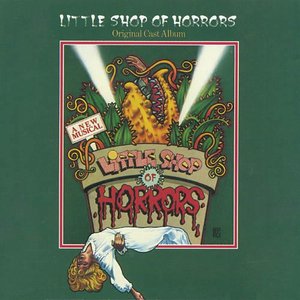
Little Shop of Horrors is a horror comedy rock musical with music by Alan Menken and lyrics and a book by Howard Ashman. The story follows a hapless florist shop worker who raises a plant that feeds on human blood and flesh. The musical is loosely based on the low-budget 1960 black comedy film The Little Shop of Horrors. The music, composed by Menken in the style of early 1960s rock and roll, doo-wop and early Motown, includes several well-known tunes, including the title song, "Skid Row (Downtown)", "Somewhere That's Green", and "Suddenly, Seymour".
"Everything's Coming Up Roses" is a song with music by Jule Styne and lyrics by Stephen Sondheim, written initially for the 1959 Broadway musical Gypsy. Introduced in the show's inaugural production by Ethel Merman, "Everything's Coming Up Roses" became one of Merman's signature songs.
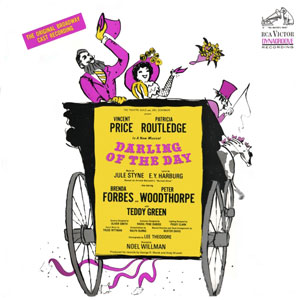
Darling of the Day is a musical with a book by Nunnally Johnson, lyrics by E. Y. Harburg, and music by Jule Styne. It is based on Arnold Bennett's novel Buried Alive and his play The Great Adventure. Patricia Routledge won the Tony Award for Best Actress in a Musical for her performance in the 1968 Broadway production.
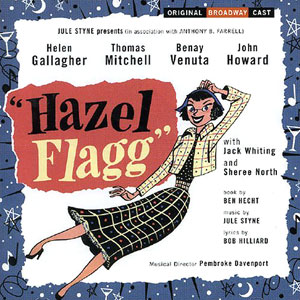
Hazel Flagg is a 1953 musical, book by Ben Hecht, based on a story by James H. Street. The lyrics are by Bob Hilliard, and music by Jule Styne. The musical is based on the 1937 screwball comedy film Nothing Sacred, the primary screenwriter of which was Ben Hecht.
Susan Birkenhead is an American lyricist.

Ankles Aweigh is a musical with a book by Guy Bolton and Eddie Davis, lyrics by Dan Shapiro, and music by Sammy Fain. The plot involves Hollywood starlet Wynne, who secretly marries a Navy pilot while filming a movie in Sicily. She disguises herself as a sailor and stows away on his ship to grab a covert honeymoon. They get mixed up with an espionage ring.
Scott Wise is an American theatre actor and dancer. He is known for his performances in the 1989 musical Jerome Robbins' Broadway, which earned him a Tony Award, and in the 2002 film Chicago.
Miles E. White was a top costume designer of Broadway musicals for 25 years. He is known in the entertainment industry for his well rendered, prolific, imaginative and witty designs. He won recognition, including four Donaldson Awards and two Tony Awards.
The 2nd Tony Awards were held on March 28, 1948, at the Waldorf-Astoria Grand Ballroom in New York City, and broadcast on radio station WOR and the Mutual Network. The Masters of Ceremonies were Harry Hershfield, Bert Lytell, and Hiram Sherman. The Antoinette Perry Awards for Excellence in Theatre, or more commonly, the Tony Awards, recognize achievement in live Broadway productions and performances, plus several non-competitive Special Awards. They are presented by the American Theatre Wing and the League of American Theatres and Producers at an annual ceremony in New York City.
Warren Carlyle is a British director and choreographer who was born in Norwich, Norfolk, England. He received Drama Desk Award nominations for Outstanding Choreography and Outstanding Director of a Musical for the 2009 revival of Finian's Rainbow.
The Donaldson Awards were a set of theatre awards established in 1944 by the drama critic Robert Francis in honor of W. H. Donaldson (1864–1925), the founder of The Billboard magazine.

Jack Whiting was an American actor, singer and dancer whose career ran from the early 1920s through the late 1950s, playing leading men or major supporting figures.











